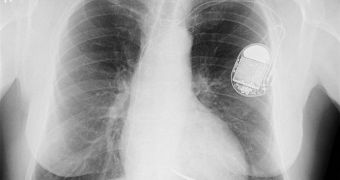Experts with Medtronic say that they recently completed work on a groundbreaking new device, a pacemaker so small that it could literally be injected in the bodies of patients who need it.
The company, the largest maker of medical devices in the world, is using microelectronic technology and advanced chip-manufacturing methods to shrink the average sizes of pacemakers to levels never-before achieved.
Traditionally, pacemakers have been used to regulate the rhythm of the heart in people who need it. They are rather small, implantable devices, and their role is to transmit small electrical impulses to various regions of the heart when the organ gets sloppy in doing this itself.
But even the most advanced heart rhythm regulators today are still several centimeters in size. This is why Medtronic decided to purse a new type of pacemaker entirely, one that would not be larger than a Tic Tac.
The main advantage with the new device is that it can be inserted into its correct position by using a catheter (a large needle) rather than via invasive surgery. Currently, there is no other way of inserting such devices into the human body.
According to officials at the company, the new device could be made available to the general public within less than five years. At this point, it's still a research instrument, explains Medtronic's senior vice-president for medicine and technology, Stephen Oesterle.
The small pacemaker features numerous components, including a circuit board to manage data, an oscillator for generating current, a small capacitor for rapid electrical discharge, a telemetry system for wireless data transfer to an external receiver, and the memory needed to store the data.
The substrate is a type of wafer that Medtronic creates at its own wafer fabrication plant in Arizona, and all of the aforementioned components are installed on such a substrate directly.
A single, 6-inch wafer can be used to manufacture anywhere between 60 and 70 pacemakers, officials with the corporation explain. “What we don't have that is fundamental to a pacemaker is a way to power the chip,” Oesterle explains.
An added advantage with the new device is that its small size means it can be inserted nearly anywhere around the heart. This in turn reduces the demand for stronger currents, and allows miniaturization.
“If you have the pacing element at the area you want to pace, it doesn't take much power. All you need to do is stimulate one cell in the heart and create a wave of depolarization,” Oesterle concludes, quoted by Technology Review.

 14 DAY TRIAL //
14 DAY TRIAL //